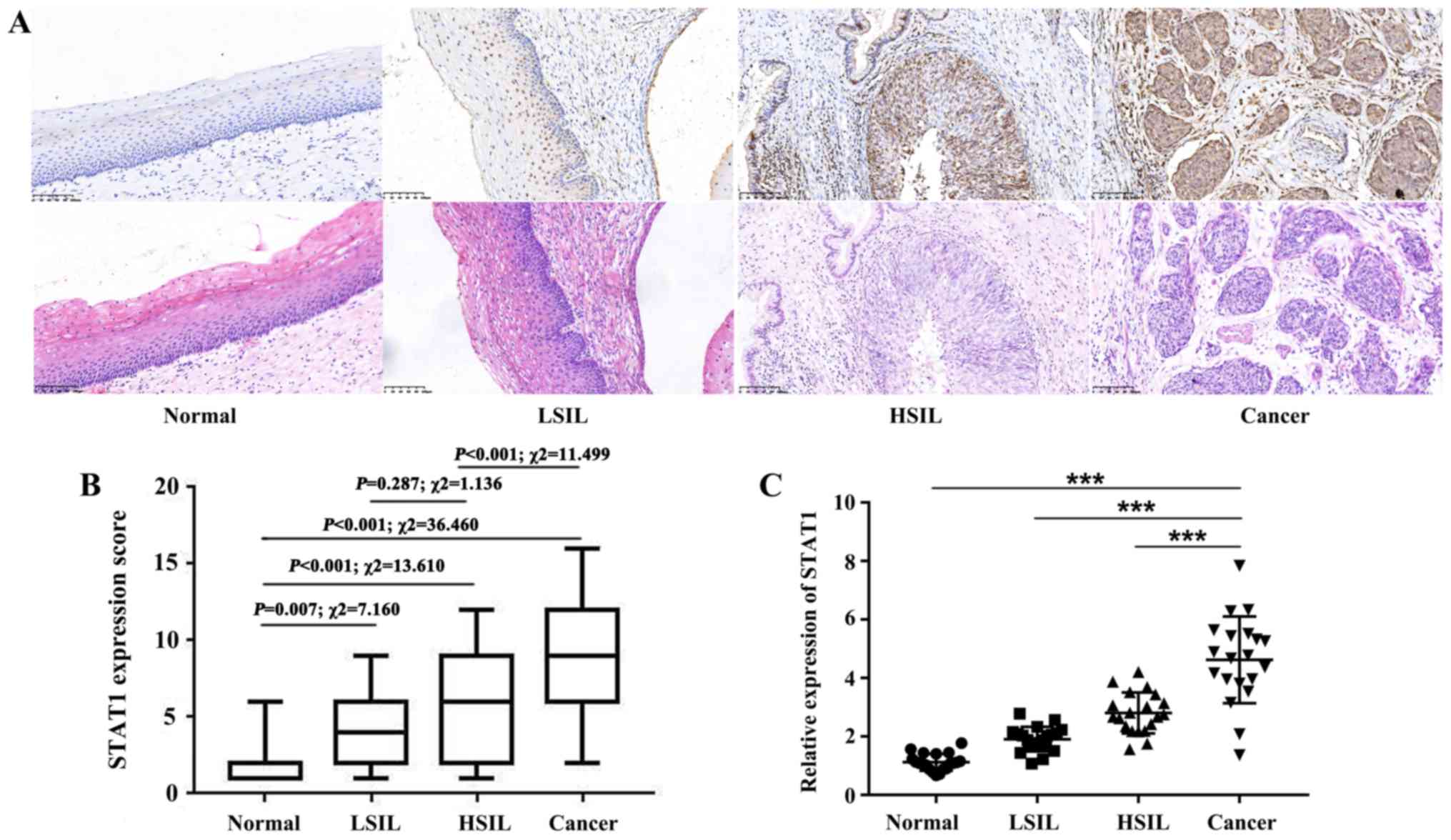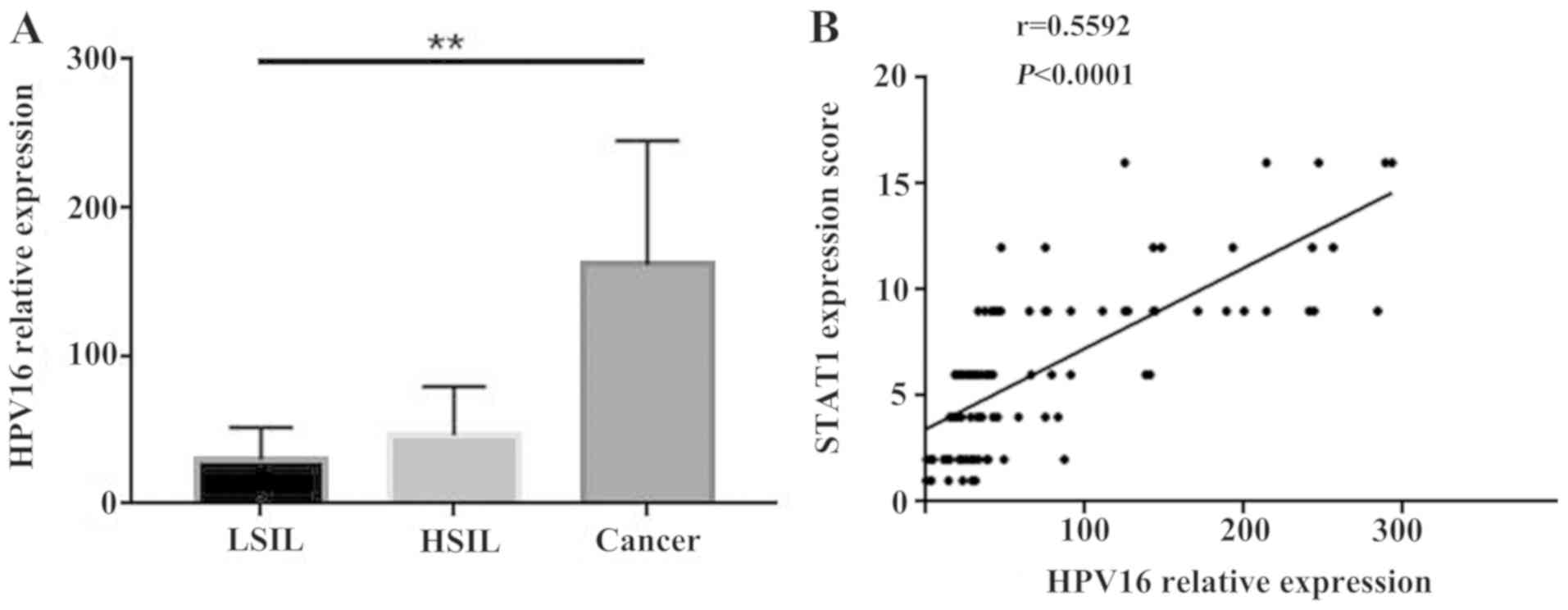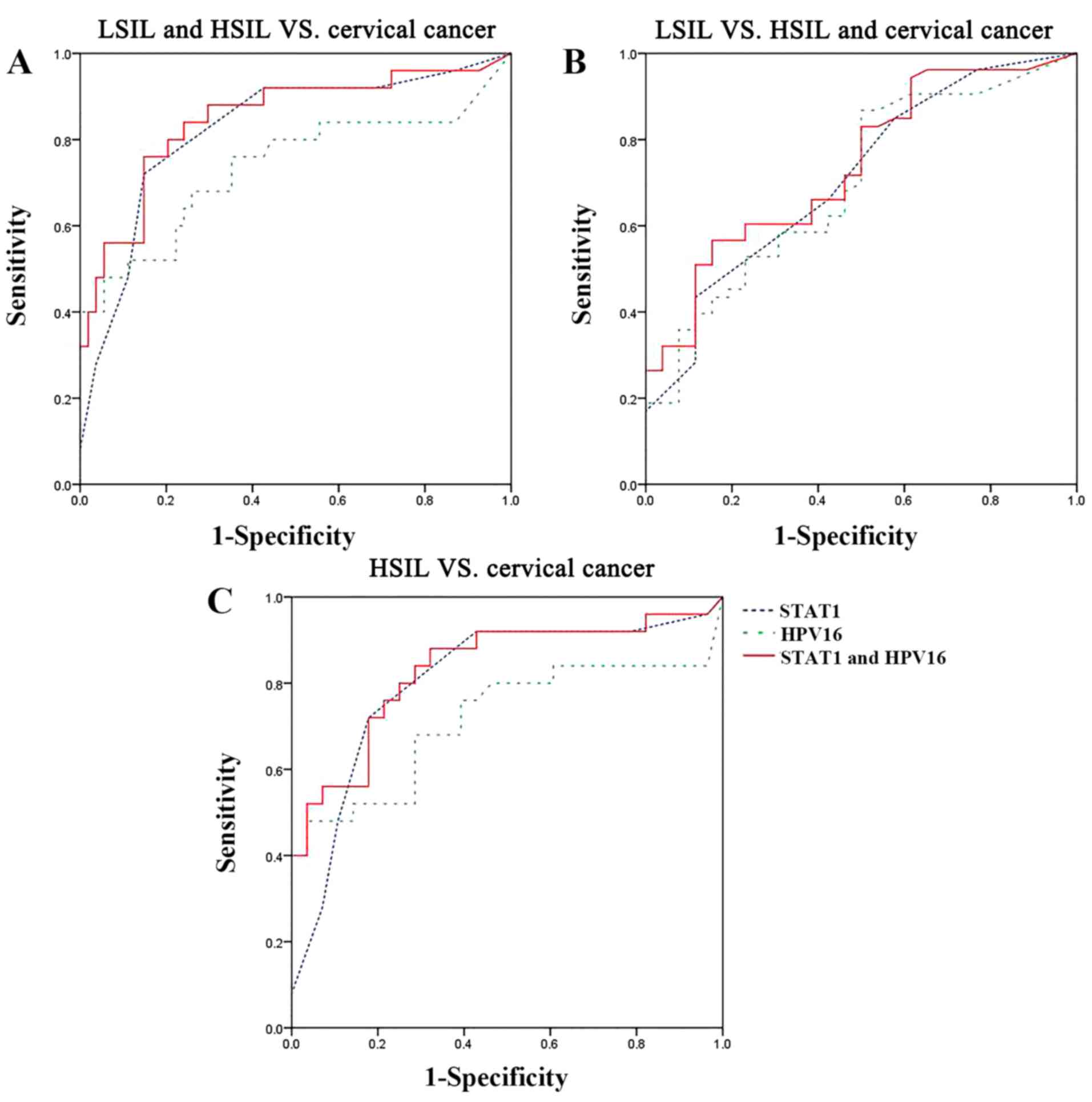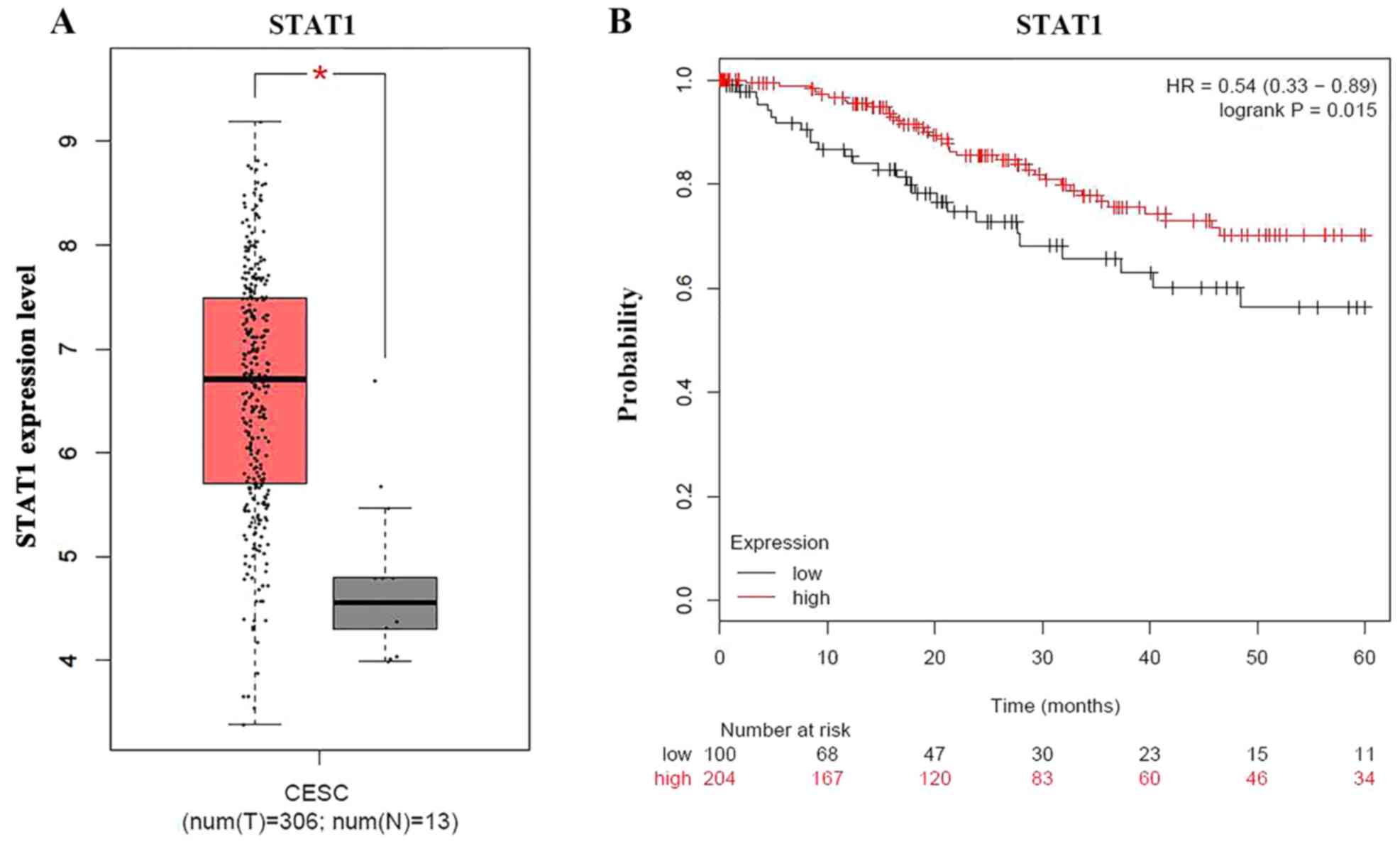|
1
|
Cohen PA, Jhingran A, Oaknin A and Denny
L: Cervical cancer. Lancet. 393:169–182. 2019. View Article : Google Scholar : PubMed/NCBI
|
|
2
|
Crosbie EJ, Einstein MH, Franceschi S and
Kitchener HC: Human papillomavirus and cervical cancer. Lancet.
382:889–899. 2013. View Article : Google Scholar : PubMed/NCBI
|
|
3
|
Small W Jr, Bacon MA, Bajaj A, Chuang LT,
Fisher BJ, Harkenrider MM, Jhingran A, Kitchener HC, Mileshkin LR,
Viswanathan AN and Gaffney DK: Cervical cancer: A global health
crisis. Cancer. 123:2404–2412. 2017. View Article : Google Scholar : PubMed/NCBI
|
|
4
|
Nitecki R and Feltmate CM: Human
papillomavirus and nonhuman papillomavirus pathways to vulvar
squamous cell carcinoma: A review. Curr Probl Cancer. 42:476–485.
2018. View Article : Google Scholar : PubMed/NCBI
|
|
5
|
Latsuzbaia A, Tapp J, Nguyen T, Fischer M,
Arbyn M, Weyers S and Mossong J: Analytical performance evaluation
of Anyplex II HPV28 and Euroarray HPV for genotyping of cervical
samples. Diagn Microbiol Infect Dis. 85:318–322. 2016. View Article : Google Scholar : PubMed/NCBI
|
|
6
|
Tang A, Dadaglio G, Oberkampf M, Di Carlo
S, Peduto L, Laubreton D, Desrues B, Sun CM, Montagutelli X and
Leclerc C: B cells promote tumor progression in a mouse model of
HPV-mediated cervical cancer. Int J Cancer. 139:1358–1371. 2016.
View Article : Google Scholar : PubMed/NCBI
|
|
7
|
Chatzistamatiou K, Moysiadis T, Moschaki
V, Panteleris N and Agorastos T: Comparison of cytology, HPV DNA
testing and HPV 16/18 genotyping alone or combined targeting to the
more balanced methodology for cervical cancer screening. Gynecol
Oncol. 142:120–127. 2016. View Article : Google Scholar : PubMed/NCBI
|
|
8
|
Hong S and Laimins LA: The JAK-STAT
transcriptional regulator, STAT-5, activates the ATM DNA damage
pathway to induce HPV 31 genome amplification upon epithelial
differentiation. PLoS Pathogens. 9:e10032952013. View Article : Google Scholar : PubMed/NCBI
|
|
9
|
Prabhavathy D, Vijayalakshmi R, Kanchana
MP and Karunagaran D: HPV16 E2 enhances the expression of NF-κB and
STAT3 target genes and potentiates NF-κB activation by inflammatory
mediators. Cell Immunol. 292:70–77. 2014. View Article : Google Scholar : PubMed/NCBI
|
|
10
|
Galloway DA, Morgan EL and Macdonald A:
Autocrine STAT3 activation in HPV positive cervical cancer through
a virus-driven Rac1-NFκB-IL-6 signalling axis. PLoS Pathogens.
15:e10078352019. View Article : Google Scholar : PubMed/NCBI
|
|
11
|
Hong S, Mehta KP and Laimins LA:
Suppression of STAT-1 expression by human papillomaviruses is
necessary for differentiation-dependent genome amplification and
plasmid maintenance. J Virol. 85:9486–9494. 2011. View Article : Google Scholar : PubMed/NCBI
|
|
12
|
Manavi M, Hudelist G, Fink-Retter A,
Gschwandtler-Kaulich D, Pischinger K and Czerwenka K: Gene
profiling in Pap-cell smears of high-risk human
papillomavirus-positive squamous cervical carcinoma. Gynecol Oncol.
105:418–426. 2007. View Article : Google Scholar : PubMed/NCBI
|
|
13
|
Verhoeven Y, Tilborghs S, Jacobs J, De
Waele J, Quatannens D, Deben C, Prenen H, Pauwels P, Trinh XB,
Wouters A, et al: The potential and controversy of targeting STAT
family members in cancer. Semin Cancer Biol. 60:41–56. 2020.
View Article : Google Scholar : PubMed/NCBI
|
|
14
|
Merlos-Suarez A, Barriga FM, Jung P,
Iglesias M, Céspedes MV, Rossell D, Sevillano M, Hernando-Momblona
X, da Silva-Diz V, Muñoz P, et al: The intestinal stem cell
signature identifies colorectal cancer stem cells and predicts
disease relapse. Cell Stem Cell. 8:511–524. 2011. View Article : Google Scholar : PubMed/NCBI
|
|
15
|
Chen J, Zhao J, Chen L, Dong N, Ying Z,
Cai Z, Ji D, Zhang Y, Dong L, Li Y, et al: STAT1 modification
improves therapeutic effects of interferons on lung cancer cells. J
Transl Med. 13:2932015. View Article : Google Scholar : PubMed/NCBI
|
|
16
|
Zhang Y, Molavi O, Su M and Lai R: The
clinical and biological significance of STAT1 in esophageal
squamous cell carcinoma. BMC Cancer. 14:7912014. View Article : Google Scholar : PubMed/NCBI
|
|
17
|
Zhang X, Li X, Tan F, Yu N and Pei H:
STAT1 Inhibits MiR-181a expression to suppress colorectal cancer
cell proliferation through PTEN/Akt. J Cell Biochem. 118:3435–3443.
2017. View Article : Google Scholar : PubMed/NCBI
|
|
18
|
Chan SR, Vermi W, Luo J, Lucini L, Rickert
C, Fowler AM, Lonardi S, Arthur C, Young LJ, Levy DE, et al:
STAT1-deficient mice spontaneously develop estrogen receptor
alpha-positive luminal mammary carcinomas. Breast Cancer Res.
14:R162012. View
Article : Google Scholar : PubMed/NCBI
|
|
19
|
Arzt L, Kothmaier H, Halbwedl I,
Quehenberger F and Popper HH: Signal transducer and activator of
transcription 1 (STAT1) acts like an oncogene in malignant pleural
mesothelioma. Virchows Arch. 465:79–88. 2014. View Article : Google Scholar : PubMed/NCBI
|
|
20
|
Greenwood C, Metodieva G, Al-Janabi K,
Lausen B, Alldridge L, Leng L, Bucala R, Fernandez N and Metodiev
MV: Stat1 and CD74 overexpression is co-dependent and linked to
increased invasion and lymph node metastasis in triple-negative
breast cancer. J Proteomics. 75:3031–3040. 2012. View Article : Google Scholar : PubMed/NCBI
|
|
21
|
Zhu H, Wang Z, Xu Q, Zhang Y, Zhai Y, Bai
J, Liu M, Hui Z and Xu N: Inhibition of STAT1 sensitizes renal cell
carcinoma cells to radiotherapy and chemotherapy. Cancer Biol Ther.
13:401–407. 2012. View Article : Google Scholar : PubMed/NCBI
|
|
22
|
Duarte CW, Willey CD, Zhi D, Cui X, Harris
JJ, Vaughan LK, Mehta T, McCubrey RO, Khodarev NN, Weichselbaum RR
and Gillespie GY: Expression signature of IFN/STAT1 signaling genes
predicts poor survival outcome in glioblastoma multiforme in a
subtype-specific manner. PLoS One. 7:e296532012. View Article : Google Scholar : PubMed/NCBI
|
|
23
|
Magkou C, Giannopoulou I, Theohari I,
Fytou A, Rafailidis P, Nomikos A, Papadimitriou C and Nakopoulou L:
Prognostic significance of phosphorylated STAT-1 expression in
premenopausal and postmenopausal patients with invasive breast
cancer. Histopathology. 60:1125–1132. 2012. View Article : Google Scholar : PubMed/NCBI
|
|
24
|
Liu SS, Leung RCY, Chan KKL, Cheung ANY
and Ngan HYS: Evaluation of a newly developed GenoArray human
papillomavirus (HPV) genotyping assay and comparison with the Roche
Linear Array HPV genotyping assay. J Clin Microbiol. 48:758–764.
2010. View Article : Google Scholar : PubMed/NCBI
|
|
25
|
Livak KJ and Schmittgen TD: Analysis of
relative gene expression data using real-time quantitative PCR and
the 2(-Delta Delta C(T)) method. Methods. 25:402–408. 2001.
View Article : Google Scholar : PubMed/NCBI
|
|
26
|
Biesaga B, Janecka A, Mucha-Malecka A,
Adamczyk A, Szostek S, Słonina D, Halaszka K and Przewoźnik M:
HPV16 detection by qPCR method in relation to quantity and quality
of DNA extracted from archival formalin fixed and paraffin embedded
head and neck cancer tissues by three commercially available kits.
J Virol Methods. 236:157–163. 2016. View Article : Google Scholar : PubMed/NCBI
|
|
27
|
Tang Z, Li C, Kang B, Gao G, Li C and
Zhang Z: GEPIA: A web server for cancer and normal gene expression
profiling and interactive analyses. Nucleic Acids Res. 45:W98–W102.
2017. View Article : Google Scholar : PubMed/NCBI
|
|
28
|
Zhang J, Zheng Z, Zheng J, Xie T, Tian Y,
Li R, Wang B, Lin J, Xu A, Huang X and Yuan Y: Epigenetic-Mediated
downregulation of zinc finger protein 671 (ZNF671) predicts poor
prognosis in multiple solid tumors. Front Oncol. 9:3422019.
View Article : Google Scholar : PubMed/NCBI
|
|
29
|
Hix LM, Karavitis J, Khan MW, Shi YH,
Khazaie K and Zhang M: Tumor STAT1 transcription factor activity
enhances breast tumor growth and immune suppression mediated by
myeloid-derived suppressor cells. J Biol Chem. 288:11676–11688.
2013. View Article : Google Scholar : PubMed/NCBI
|
|
30
|
Rajkumar T, Sabitha K, Vijayalakshmi N,
Shirley S, Bose MV, Gopal G and Selvaluxmy G: Identification and
validation of genes involved in cervical tumourigenesis. BMC
Cancer. 11:802011. View Article : Google Scholar : PubMed/NCBI
|
|
31
|
Yi Y, Fang Y, Wu K, Liu Y and Zhang W:
Comprehensive gene and pathway analysis of cervical cancer
progression. Oncol Lett. 19:3316–3332. 2020.PubMed/NCBI
|
|
32
|
Meissl K, Macho-Maschler S, Muller M and
Strobl B: The good and the bad faces of STAT1 in solid tumours.
Cytokine. 89:12–20. 2017. View Article : Google Scholar : PubMed/NCBI
|
|
33
|
Gujam FJ, McMillan DC and Edwards J: The
relationship between total and phosphorylated STAT1 and STAT3
tumour cell expression, components of tumour microenvironment and
survival in patients with invasive ductal breast cancer.
Oncotarget. 7:77607–77621. 2016. View Article : Google Scholar : PubMed/NCBI
|
|
34
|
Josahkian JA, Saggioro FP, Vidotto T,
Ventura HT, Candido Dos Reis FJ, de Sousa CB, Tiezzi DG, de Andrade
JM, Koti M and Squire JA: Increased STAT1 expression in high grade
serous ovarian cancer is associated with a better outcome. Int J
Gynecol Cancer. 28:459–465. 2018. View Article : Google Scholar : PubMed/NCBI
|
|
35
|
Guo Y, Meng X, Ma J, Zheng Y, Wang Q, Wang
Y and Shang H: Human papillomavirus 16 E6 contributes HIF-1α
induced Warburg effect by attenuating the VHL-HIF-1α interaction.
Int J Mol Sci. 15:7974–7986. 2014. View Article : Google Scholar : PubMed/NCBI
|
|
36
|
Sun Z, Zhang R, Liu Z, Liu C, Li X, Zhou
W, Yang L, Ruan Q and Zhang X: Development of a fluorescence-based
multiplex genotyping method for simultaneous determination of human
papillomavirus infections and viral loads. BMC Cancer. 15:8602015.
View Article : Google Scholar : PubMed/NCBI
|
|
37
|
Graham SV: The human papillomavirus
replication cycle, and its links to cancer progression: A
comprehensive review. Clin Sci (Lond). 131:2201–2221. 2017.
View Article : Google Scholar : PubMed/NCBI
|
|
38
|
Franceschi S, Denny L, Irwin KL, Jeronimo
J, Lopalco PL, Monsonego J, Peto J, Ronco G, Sasieni P and Wheeler
CM: Eurogin 2010 roadmap on cervical cancer prevention. Int J
Cancer. 128:2765–2774. 2011. View Article : Google Scholar : PubMed/NCBI
|
|
39
|
Camus C, Vitale S, Loubatier C, Pénaranda
G, Khiri H, Plauzolles A, Carcopino X, Halfon P and Giordanengo V:
Quantification of HPV16 E6/E7 mRNA spliced isoforms viral load as a
novel diagnostic tool for improving cervical cancer screening. J
Clin Med. 7:5302018. View Article : Google Scholar
|
|
40
|
Li N, Franceschi S, Howell-Jones R,
Snijders PJ and Clifford GM: Human papillomavirus type distribution
in 30,848 invasive cervical cancers worldwide: Variation by
geographical region, histological type and year of publication. Int
J Cancer. 128:927–935. 2011. View Article : Google Scholar : PubMed/NCBI
|
|
41
|
de Sanjose S, Quint WG, Alemany L, Geraets
DT, Klaustermeier JE, Lloveras B, Tous S, Felix A, Bravo LE, Shin
HR, et al: Human papillomavirus genotype attribution in invasive
cervical cancer: A retrospective cross-sectional worldwide study.
Lancet Oncol. 11:1048–1056. 2010. View Article : Google Scholar : PubMed/NCBI
|
|
42
|
Kjaer SK, Frederiksen K, Munk C and Iftner
T: Long-term absolute risk of cervical intraepithelial neoplasia
grade 3 or worse following human papillomavirus infection: Role of
persistence. J Natl Cancer Inst. 102:1478–1488. 2010. View Article : Google Scholar : PubMed/NCBI
|
|
43
|
Hong S, Mehta KP and Laimins LA:
Suppression of STAT-1 expression by human papillomaviruses is
necessary for differentiation-dependent genome amplification and
plasmid maintenance. J Virol. 85:9486–9494. 2011. View Article : Google Scholar : PubMed/NCBI
|
|
44
|
Bordignon V, Di Domenico EG, Trento E,
D'Agosto G, Cavallo I, Pontone M, Pimpinelli F, Mariani L and
Ensoli F: How human papillomavirus replication and immune evasion
strategies take advantage of the host dna damage repair machinery.
Viruses. 9:3902017. View Article : Google Scholar
|
|
45
|
Smeets SJ, van der Plas M, Schaaij-Visser
TB, van Veen EA, van Meerloo J, Braakhuis BJ, Steenbergen RD and
Brakenhoff RH: Immortalization of oral keratinocytes by functional
inactivation of the p53 and pRb pathways. Int J Cancer.
128:1596–1605. 2011. View Article : Google Scholar : PubMed/NCBI
|
|
46
|
Shukla S, Shishodia G, Mahata S, Hedau S,
Pandey A, Bhambhani S, Batra S, Basir SF, Das BC and Bharti AC:
Aberrant expression and constitutive activation of STAT3 in
cervical carcinogenesis: Implications in high-risk human
papillomavirus infection. Mol Cancer. 9:2822010. View Article : Google Scholar : PubMed/NCBI
|
|
47
|
Shukla S, Mahata S, Shishodia G, Pandey A,
Tyagi A, Vishnoi K, Basir SF, Das BC and Bharti AC: Functional
regulatory role of STAT3 in HPV16-mediated cervical carcinogenesis.
PLoS One. 8:e678492013. View Article : Google Scholar : PubMed/NCBI
|
|
48
|
Han W, Carpenter RL, Cao X and Lo HW:
STAT1 gene expression is enhanced by nuclear EGFR and HER2 via
cooperation with STAT3. Mol Carcinog. 52:959–969. 2013. View Article : Google Scholar : PubMed/NCBI
|
|
49
|
Oh JE, Kim JO, Shin JY, Zhang XH, Won HS,
Chun SH, Jung CK, Park WS, Nam SW, Eun JW and Kang JH: Molecular
genetic characterization of p53 mutated oropharyngeal squamous cell
carcinoma cells transformed with human papillomavirus E6 and E7
oncogenes. Int J Oncol. 43:383–393. 2013. View Article : Google Scholar : PubMed/NCBI
|
|
50
|
Khodarev N, Ahmad R, Rajabi H, Pitroda S,
Kufe T, McClary C, Joshi MD, MacDermed D, Weichselbaum R and Kufe
D: Cooperativity of the MUC1 oncoprotein and STAT1 pathway in poor
prognosis human breast cancer. Oncogene. 29:920–929. 2010.
View Article : Google Scholar : PubMed/NCBI
|
|
51
|
Lynch RA, Etchin J, Battle TE and Frank
DA: A small-molecule enhancer of signal transducer and activator of
transcription 1 transcriptional activity accentuates the
antiproliferative effects of IFN-gamma in human cancer cells.
Cancer Res. 67:1254–1261. 2007. View Article : Google Scholar : PubMed/NCBI
|
|
52
|
Klampfer L: Signal transducers and
activators of transcription (STATs): Novel targets of
chemopreventive and chemotherapeutic drugs. Curr Cancer Drug
Targets. 6:107–121. 2006. View Article : Google Scholar : PubMed/NCBI
|
|
53
|
Khodarev NN, Beckett M, Labay E, Darga T,
Roizman B and Weichselbaum RR: STAT1 is overexpressed in tumors
selected for radioresistance and confers protection from radiation
in transduced sensitive cells. Proc Proc Natl Acad Sci USA.
101:1714–1719. 2004. View Article : Google Scholar : PubMed/NCBI
|
|
54
|
Koebel CM, Vermi W, Swann JB, Zerafa N,
Rodig SJ, Old LJ, Smyth MJ and Schreiber RD: Adaptive immunity
maintains occult cancer in an equilibrium state. Nature.
450:903–907. 2007. View Article : Google Scholar : PubMed/NCBI
|
|
55
|
Khodarev NN, Roizman B and Weichselbaum
RR: Molecular pathways: Interferon/stat1 pathway: Role in the tumor
resistance to genotoxic stress and aggressive growth. Clin Cancer
Res. 18:3015–3021. 2012. View Article : Google Scholar : PubMed/NCBI
|
|
56
|
Hui Z, Tretiakova M, Zhang Z, Li Y, Wang
X, Zhu JX, Gao Y, Mai W, Furge K, Qian CN, et al:
Radiosensitization by inhibiting STAT1 in renal cell carcinoma. Int
J Radiat Oncol Biol Phys. 73:288–295. 2009. View Article : Google Scholar : PubMed/NCBI
|
|
57
|
Buttarelli M, Babini G, Raspaglio G,
Filippetti F, Battaglia A, Ciucci A, Ferrandina G, Petrillo M,
Marino C, Mancuso M, et al: A combined ANXA2-NDRG1-STAT1 gene
signature predicts response to chemoradiotherapy in cervical
cancer. J Exp Clin Cancer Res. 38:2792019. View Article : Google Scholar : PubMed/NCBI
|


















